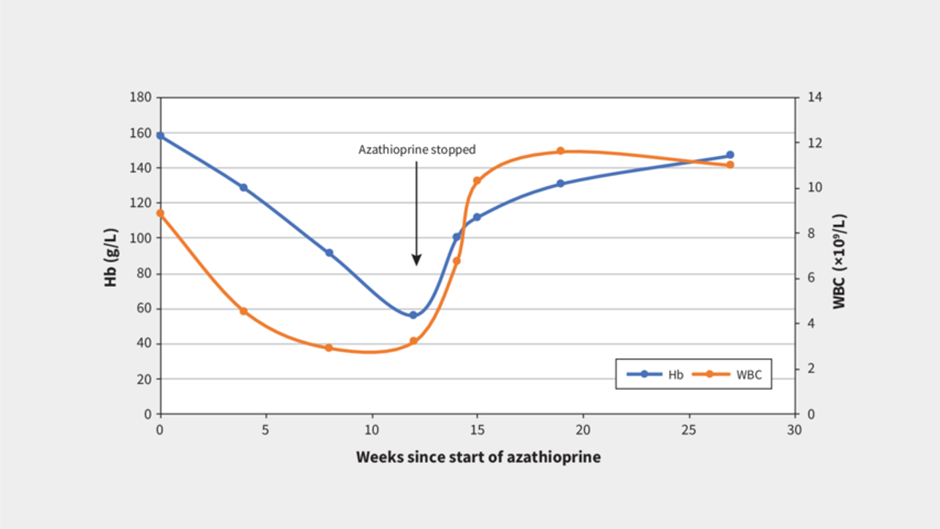A nurse is caring for a client who is taking azathioprine to treat rheumatoid arthritis. Which of the following laboratory values indicates an adverse effect of this medication?
BUN 15 mg/dL
WBC 3,000/mm
Hct 45%
Platelets 250,000/mm
The Correct Answer is B
Choice A Reason:
BUN 15 mg/dL (blood urea nitrogen) is incorrect. An elevated BUN level can indicate kidney dysfunction or dehydration, but it's not typically associated with azathioprine's adverse effects. Azathioprine is known to affect bone marrow, leading to decreased blood cell counts, rather than directly impacting kidney function.
Choice B Reason:
WBC 3,000/mm³ (low white blood cell count) is correct. Azathioprine is an immunosuppressive medication used to treat various conditions, including rheumatoid arthritis. One of its known adverse effects is bone marrow suppression, which can lead to decreased production of blood cells, including white blood cells (WBCs). A low WBC count (leukopenia) can increase the risk of infections due to compromised immune function, making it an important adverse effect to monitor in individuals taking azathioprine.
Choice C Reason:
Hct 45% (hematocrit) is incorrect. A hematocrit of 45% is within the normal range for both men and women. Azathioprine adverse effects usually manifest as blood cell-related issues (such as leukopenia) rather than directly impacting hematocrit levels.
Choice D Reason:
Platelets 250,000/mm³: Platelets within the range of 150,000 to 400,000/mm³ are considered normal. Azathioprine typically affects white blood cells more prominently than platelet counts.

Nursing Test Bank
Naxlex Comprehensive Predictor Exams
Related Questions
Correct Answer is B
Explanation
Choice A Reason:
"You should report monthly to have your blood drawn to monitor kidney function while taking medication." Is incorrect. While monitoring kidney function might be necessary during tuberculosis treatment due to potential medication side effects, monthly blood draws specifically for kidney function might not be standard. However, periodic blood tests to monitor various parameters, including kidney function, are part of tuberculosis treatment monitoring.
Choice B Reason:
"You will need to take two or more medications to treat your disease." Is correct. Treatment for active pulmonary tuberculosis typically involves a combination of antimicrobial medications to effectively treat the infection and prevent antibiotic resistance. This multidrug therapy is essential to combat the bacteria causing tuberculosis and reduce the risk of treatment failure or relapse.
Choice C Reason:
"You will need to undergo tuberculin skin tests every 6 months while taking medication for your disease." Is incorrect. Tuberculin skin tests are used for screening or diagnosing tuberculosis but are not typically repeated every six months during active treatment for the disease.
Choice D Reason:
"You should anticipate taking medication to treat your disease for at least the next 3 years." Is incorrect. The duration of treatment for active pulmonary tuberculosis varies but is typically shorter than three years. Treatment duration usually lasts several months to a year, depending on the specific medication regimen and the response to treatment.

Correct Answer is C
Explanation
Choice A Reason:
"Limit your sodium intake." Is incorrect. Sodium restriction might be appropriate for some cardiovascular or renal conditions, but it is not specifically related to theophylline use.
Choice B Reason:
"Restrict milk products." is incorrect. Restricting milk products is not a necessary dietary consideration for theophylline. However, consuming high-fat dairy products may delay the absorption of theophylline, potentially affecting its effectiveness.
Choice C Reason:
"Avoid caffeinated beverages." Is correct. Theophylline is a bronchodilator used to treat respiratory conditions like asthma or chronic obstructive pulmonary disease (COPD). It belongs to the class of methylxanthine medications and acts similarly to caffeine. Consuming additional caffeine through beverages like coffee, tea, or certain sodas can increase the risk of adverse effects associated with theophylline, such as increased heart rate or nervousness. Hence, avoiding caffeinated beverages is advisable to minimize the risk of exacerbating these effects.
Choice D Reason:
"Take the medication with meals." Taking theophylline with or without meals is typically acceptable, but it's essential to maintain consistency in timing and avoid significant changes in dietary habits that might affect its absorption or metabolism.
Whether you are a student looking to ace your exams or a practicing nurse seeking to enhance your expertise , our nursing education contents will empower you with the confidence and competence to make a difference in the lives of patients and become a respected leader in the healthcare field.
Visit Naxlex, invest in your future and unlock endless possibilities with our unparalleled nursing education contents today
Report Wrong Answer on the Current Question
Do you disagree with the answer? If yes, what is your expected answer? Explain.
Kindly be descriptive with the issue you are facing.
